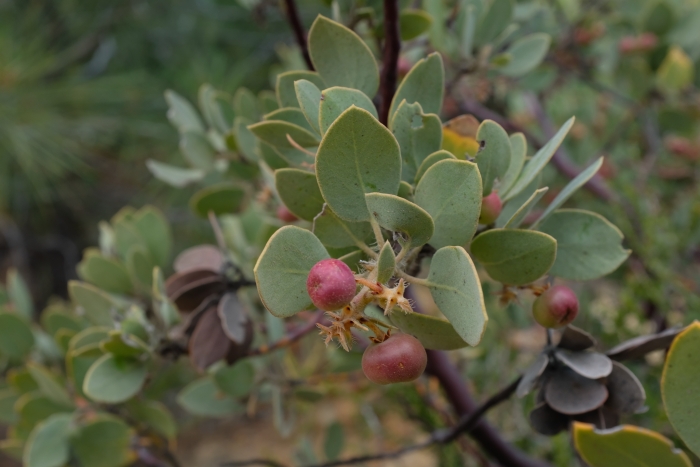La Panza Manzanita
(Arctostaphylos pilosula)
La Panza Manzanita (Arctostaphylos pilosula)
/
/

paulexcoff
CC BY-SA 4.0
Image By:
paulexcoff
Recorded By:
Copyright:
CC BY-SA 4.0
Copyright Notice:
Photo by: paulexcoff | License Type: CC BY-SA 4.0 | License URL: http://creativecommons.org/licenses/by-sa/4.0/ | Rights Holder: paulexcoff | Publisher: iNaturalist | Date Created: 2020-05-17T12:49:38-07:00 |

























Estimated Native Range
Summary
Arctostaphylos pilosula, commonly known as La Panza manzanita or Santa Margarita manzanita, is an erect and bristly evergreen shrub native to the chaparral and closed-cone pine forests of California. Specifically, it is found in the La Panza Range, the east slope of the Santa Lucia Mountains, and the San Luis Range. It thrives at elevations between 98-4,101 feet (30-1,250 meters). The shrub typically grows to a height of 2-6 feet (0.6-1.8 meters) and has a similar spread. La Panza manzanita is notable for its reddish exfoliating bark and dense foliage of small, bristly leaves. From December to March, it produces showy spherical white inflorescences of urn-shaped flowers, followed by reddish-brown drupes in the summer.
La Panza manzanita is valued for its ornamental qualities, including its attractive bark and flowers. It is used in native plant gardens, for erosion control, and as a habitat plant for wildlife. This species prefers well-drained soils, requires little water once established, and does best in full sun to partial shade. While it is adaptable to various soil types, it is sensitive to overwatering and root rot. Due to its endangered status, cultivation should be approached responsibly, ensuring that plants are sourced from reputable nurseries and not wild populations.CC BY-SA 4.0
La Panza manzanita is valued for its ornamental qualities, including its attractive bark and flowers. It is used in native plant gardens, for erosion control, and as a habitat plant for wildlife. This species prefers well-drained soils, requires little water once established, and does best in full sun to partial shade. While it is adaptable to various soil types, it is sensitive to overwatering and root rot. Due to its endangered status, cultivation should be approached responsibly, ensuring that plants are sourced from reputable nurseries and not wild populations.CC BY-SA 4.0
Plant Description
- Plant Type: Shrub
- Height: 4-8 feet
- Width: 4-8 feet
- Growth Rate: Moderate
- Flower Color: Pink, White
- Flowering Season: Spring, Winter
- Leaf Retention: Evergreen
Growth Requirements
- Sun: Full Sun, Part Shade
- Water: Low
- Drainage: Medium, Fast
Common Uses
Bee Garden, Bird Garden, Drought Tolerant, Hummingbird Garden, Low Maintenance
Natural Habitat
Native to chaparral and closed-cone pine forests within specific ranges in California
Other Names
Common Names: Santa Rita Manzanita, Santa Margarita Manzanita, Hairy Manzanita
Scientific Names: , Arctostaphylos pilosula, Arctostaphylos pilosula f. microphylla, Arctostaphylos pilosula subsp. pilosula, Arctostaphylos pilosula subsp. pismoensis,
GBIF Accepted Name: